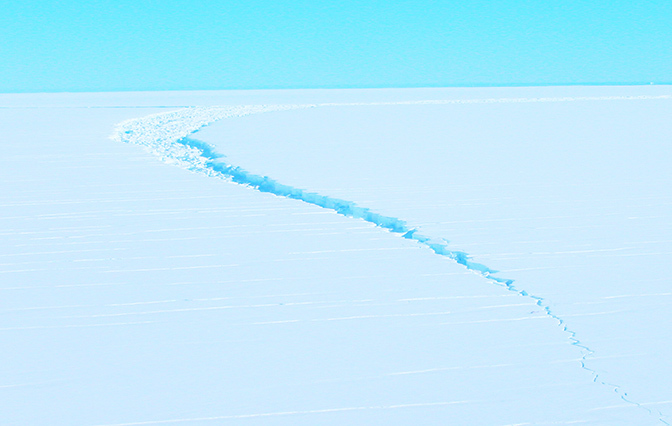Why sea level rise models have been wrong
A Q&A with Jeremy Bassis, an expert on ice dynamics and contributing author of the IPCC’s latest report.
A Q&A with Jeremy Bassis, an expert on ice dynamics and contributing author of the IPCC’s latest report.

A new international report details how climate change is affecting the world’s oceans and ice, and it recommends urgent and coordinated action to reduce carbon dioxide emissions.
The report, by the Intergovernmental Panel on Climate Change (IPCC), says that: Sea levels are rising more than twice as fast as they did in the 20th century, and that pace is accelerating. Flooding events that used to happen once every 100 years are likely to begin occurring annually in low-lying coastal areas. And ocean warming has shifted fish populations and food supplies, among other consequences.
Jeremy Bassis, a professor of climate and space sciences and engineering who studies ice dynamics, is a contributing author of the report. He answered questions from Michigan Engineering.
There are a couple of reasons. One of the major reasons is that we are seeing ice sheets pushed to a point where processes are coming into play that we hadn’t seen before. And we’re still struggling to understand these processes. We saw this in the early 2000s with the complete disintegration of sections of the Larsen B ice shelf. Researchers knew that this region was one of the more rapidly warming places on the planet and that it was likely to be one of the first dominos to fall as atmospheric temperatures increased, but the speed of the disintegration was shocking at the time and I think we are still trying to fully understand the spectrum of processes that led to it.
We see similar things in the Amundsen Sea Embayment of West Antarctica, where warm ocean waters are triggering retreat of a swath of glaciers. To really understand and predict this, we need to understand not only the ice, but also the oceans and how the oceans and ice interact. These have been difficult processes to observe.
Back in 2012 Catherine Walker (a graduate student in my lab who is now at Woods Hole) and I made a simple calculation to show that if the calving cliff of glaciers gets too big, they could be unstable and start to break apart. We speculated that portions of West Antarctica that were then retreating could eventually expose a really deep, thick calving front and trigger an instability where the ice would just keep breaking as it retreats it deeper water (and thicker ice). This type of catastrophic failure had never been observed before so there wasn’t a lot of interest at the time.
But in 2016 Rob DeConto and David Pollard added this type of process into one of their models. They found that including this instability, which they called the marine ice cliff instability, allowed them to match past sea level changes. Then, when they included it in forward projections, they found that the marine ice cliff instability significantly increased future sea level rise compared to model runs without this process. I think that study is what got the community’s attention.
Since then there have been a few studies that show that some of the biggest glaciers in Greenland might actually be close to a marine ice cliff type of calving regimes. But the idea is still pretty new and we don’t really understand the process well enough to confidently say how fast the ice can disintegration and if there are stabilizing feedbacks.
We are currently involved in a project that is joint with the UK to really look hard and see if we can understand what is going on at one of the most vulnerable glaciers in West Antarctica, the Thwaites Glacier. Part of that involves teams that are making some amazing measurements in the area. Our contribution, joint with Doug Benn at St. Andrews, is really trying to understand how the ice flows and breaks and how this contributes to the instability.
I prefer to avoid all of the pessimism. Fundamentally, every projection we make shows that the warmer it gets, the worse it is for sea level rise. Keeping to the more minor emission scenarios in the IPCC do a lot to limit or at least forestall some of the more dire sea level projections. So yes, things may currently look bad. But our outcome is going to depend on decisions that we make now and continue to make in the future.